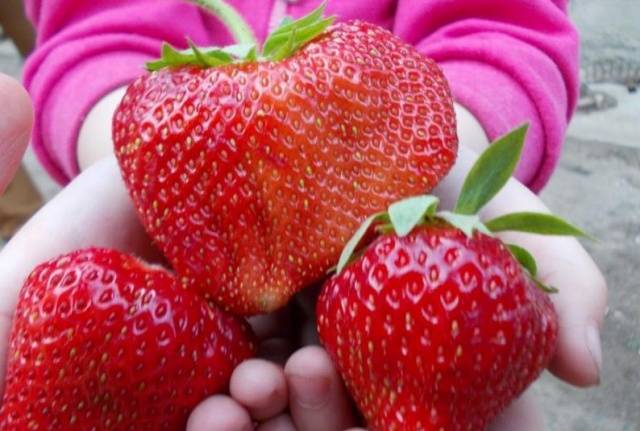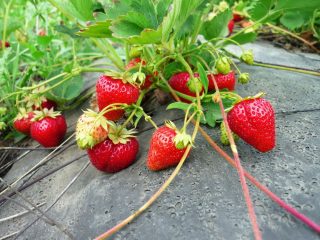Content
Both children and adults love fragrant strawberries. Today you can find different varieties that differ in size and taste. That is why it is not easy for gardeners to make a choice. One of the varieties that has interested fans is the Gigantella Maxim strawberry.
This is a Dutch variety of strawberry, distinguished by the power of its bushes and berries. Look at the photo below what the fruits look like next to a matchbox. To get a decent harvest, you need to follow the basics of agricultural technology, otherwise the variety may degenerate and be crushed. We will talk about the qualities of the berry, the characteristics of the plant, and how to care for the Gigantella variety.
Description
When creating the variety, Dutch breeders dreamed of getting mid-season strawberries with huge fruits. They succeeded quite well.
Strawberry Gigantella in the description of the variety, photos and reviews from gardeners fully corresponds to the real results. And this contributes to the growing popularity of the variety.
- The strawberry bush is powerful, spreading, its height can be almost half a meter, so the plants are not planted close.
- The leaves of the Gigantella Maxim variety are large, juicy green, shiny, and slightly corrugated.
- Gigantella begins to bear fruit in open ground in the second half of July, when grown under film 2 weeks earlier.One strawberry bush produces up to 30 flower stalks. Each of them blooms from 6 to 8 flowers.
- It produces a harvest only once, but due to large berries weighing up to 60 and sometimes up to 100 grams, it meets the expectations of gardeners.
- The berries are bright scarlet, with white specks, dense, juicy. You can determine that the Gigantella strawberries have almost reached the desired condition by looking at the nose, which gradually turns from white to scarlet. The fruits are very sweet, with a subtle pineapple aftertaste.
- Strawberries of the Gigantella variety can be grown in one place for no more than 8 years.
Characteristic
The high yield of Gigantella strawberries attracts not only private owners, but also large agricultural producers. If you follow agricultural techniques, you can collect more than 3 kg of juicy, aromatic fruits from one bush.
As noted in the description, the Gigantella strawberry variety is famous for its dense berries. This quality is highly valued by gardeners, since during transportation the fruits do not wrinkle or bleed juice.
The taste qualities have not gone unnoticed by culinary experts: the berries are used in compotes, jams, and confitures. Fully retains its presentation when frozen.
Reproduction methods
Despite the fact that you can grow Maxim strawberries in one place for up to 8 years, they will still have to be replaced. You can get new plants in traditional ways for the species:
- seeds;
- rooting the mustache;
- dividing the bush.
Propagating Gigantella strawberries by seeds is not only the most labor-intensive method, but the harvest can only be harvested the next year. Rooted tendrils or root divisions bloom in the year of planting.
About growing large-fruited garden strawberries Gigantella from seeds:
Planting strawberries in the ground
Since the Gigantella strawberry fruits are quite large, it is clear that it needs good nutritious soil. In this case, the harvest will correspond to the characteristics in all respects. The plant likes loamy soils, into which organic matter or mineral fertilizers have been added.
The predecessors of Gigantella strawberries can be plantings of peas, beans, beans, and lentils. It’s even better to plant plants in soil that has been given a season to rest. In central Russia, plants can be planted in open ground at the end of April, beginning of May, since the remontant variety is frost-resistant.
Immediately before planting strawberries, the soil is spilled with water and holes for seedlings are marked.
When planting plants, pay attention to the planting depth. The growing points should remain above the surface of the loose soil. Look at the photo below how a gardener does this.
Plant care
There are no particular difficulties when growing Gigantella strawberries. Gardeners write about this in their reviews. Agricultural technology is almost identical to other varieties. Although some nuances when growing Gigantella strawberries are still worth paying attention to:
- The bush grows rapidly, throwing out a huge number of mustaches. If you want a good harvest, you should remove them as they appear. To obtain planting material, a few bushes are enough. They only add 5 tendrils for rooting, so as not to weaken the mother bush.
- Gigantella is also grown using the carpet method, rooting all the mustaches. New rosettes, as the foliage grows, begin to produce flower stalks and produce a harvest in the first year.
Useful tips
- If strawberries are planted simply in the ground (the bed is not covered with black non-woven material), it is necessary to remove them in a timely manner. weeds.
- Water the plants once every 7 days.
- Diseased strawberry bushes should be removed immediately.
- Before setting fruit, the soil must be mulched to prevent rotting of garden strawberries.
- To grow a rich harvest, do not forget about fertilizing before fruiting. Water the bushes with sodium sulfate and nitrophoska. Repeated feeding is carried out after harvesting with nitrophos and wood ash.
- Frost-resistant Gigantella strawberries do not need to be covered for the winter. It keeps well under snow.
Diseases and pests
The variety has a fairly high immunity to many strawberry diseases, but cannot resist some fungal diseases. First of all, this concerns gray rot. If a disease occurs, you need to remove the diseased bushes and treat the entire plantation with Fitosporin or other fungicides.
The second disease from which Gigantella strawberries suffer is non-infectious chlorosis. Foliar feeding with iron-containing preparations will help cope with this disease.
To grow a rich harvest of large, aromatic berries, you cannot do without preventive measures. Every spring and autumn, strawberry bushes should be treated with 2% Bordeaux mixture.
Among the pests, the most ardent are moles and mole crickets, slugs and snails. You can cope with pests using traditional methods. They all dislike onion and garlic skins. It is simply scattered over the beds.Between the bushes you can plant marigolds, onions, parsley, and celery.
If you follow agrotechnical standards when growing Gigantella strawberries, they will look like in the photo.
















Hello ! My husband is an ardent gardener, this spring he bought this miracle plant, it is truly wonderful, the bushes are distinguished by their very small size, we have not seen the fruits yet, but in appearance they are strawberries. Oh, and the funny sellers in online stores)))))